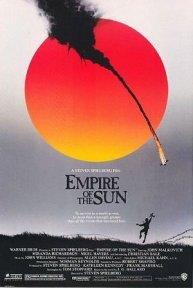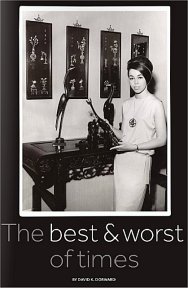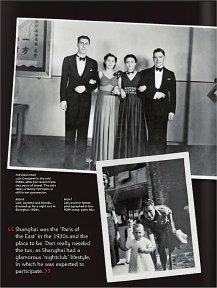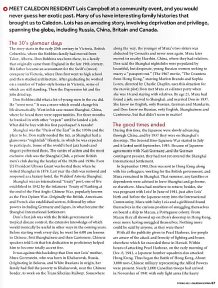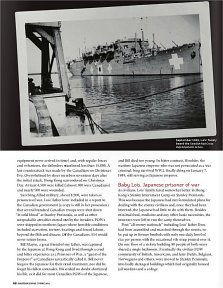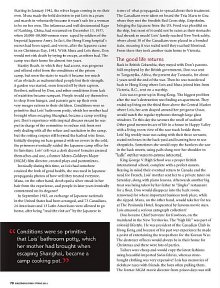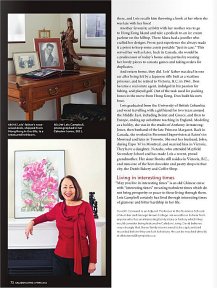Meet Caledon resident Lois Campbell at a community
event, and you would never guess her exotic past. Many of us have interesting
family histories that brought us to Caledon. Lois has an amazing story,
involving deprivation and privilege, spanning the globe, including Russia,
China, Britain and Canada.
The 30's Glamour Days
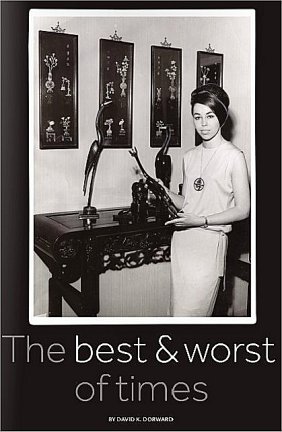 The
story starts in the early 20th century in Victoria, British Columbia, where
the Robbins family had moved from Taber, Alberta. Don Robbins was born
there, to a family that originally came from England in the late 19th century.
His father became an accountant for the Swift’s (meat) company in Victoria,
where Don first went to high school and then studied architecture. After
graduating he worked on a number of Tudor-style homes in Victoria, some
of which are still standing. Then the Depression hit and the jobs dried
up.
The
story starts in the early 20th century in Victoria, British Columbia, where
the Robbins family had moved from Taber, Alberta. Don Robbins was born
there, to a family that originally came from England in the late 19th century.
His father became an accountant for the Swift’s (meat) company in Victoria,
where Don first went to high school and then studied architecture. After
graduating he worked on a number of Tudor-style homes in Victoria, some
of which are still standing. Then the Depression hit and the jobs dried
up.
Don Robbins did what a lot of young men in the era did.
He “went west.” It was a move which would change his life dramatically.
West in his case meant Shanghai, China, where he heard there were opportunities.
For three months he bunked in with other “expats” until he landed a job.
What did he buy with his first paycheque? A tuxedo!
Shanghai was the “Paris of the East” in the 1930s and
the place to be. Don really needed the tux, as Shanghai had a glamorous
“nightclub” lifestyle, in which he was expected to participate. Some of
the world’s best jazz bands and singers performed there. The centre of
action and the most exclusive club was the Shanghai Club, a private British
men’s club during the heyday of the 1920s and 1930s. Even US President
Ulysses Grant was hosted there when he visited Shanghai in 1879. Last year
the club was restored and reopened as a luxury hotel, the Waldorf Astoria
Shanghai.
Shanghai was an international “treaty” port, one of five
established in 1842 by the infamous Treaty of Nanking at the end
of the First Anglo-Chinese War, popularly known as the First Opium War.
Originally the British, Americans and French also established sectors,
followed by other powers including Germany and Japan, in what became the
Shanghai International Settlement.
Don’s first job was with the British government in tropical
disease control, the extensive knowledge of which would ironically be useful
in other ways in the coming years. Before starting work every day, he went
for 6:00 am lessons in Chinese, first Shanghainese and then Cantonese.
Chinese speakers told Lois that his dedication to proficiency helped him
to become totally accent free.
It was against this backdrop that Don met Lois’ mother,
Mura Gorenstein, who was born in Khabarovsk, Russia. Originating in Belarus,
and White Russians in origin, her family had fled the poverty to Khabarovsk,
near the Chinese border, to work on the Trans Siberian Railway. Somewhere
along the way, the younger of Mura’s two sisters was abducted by Cossacks
and never seen again. Mura later moved to nearby Haerbin, China, where
they had relatives. Don said the Shanghai nightclubs were populated by
beautiful, but desperate, young Russian women seeking to marry a “passport
out.” (The 1967 movie, “The Countess from Hong Kong,” starring Marlon
Brando and Sophia Loren, directed by Charlie Chaplin, uses this situation
for the movie plot) Don met Mura at a dinner party when she was 16 and
staying with relatives. By age 21, Mura had found a job, moved to Shanghai,
and married Don in 1937. She knew no English, only Russian, German and
Mandarin, and Don knew no Russian, only English, Shanghainese and Cantonese,
but that didn’t seem to matter!
The Good Times Ended
During this time, the Japanese were slowly advancing
through China, and by 1937 they were on Shanghai’s doorstep. The Second
Sino-Japanese War started in July and it lasted until September, 1945.
Because of Japanese agreements with Nazi Germany, and the German contingent
present, they had not yet entered the Shanghai International Settlement.
In September 1940, Don was sent to Hong Kong along with
his colleagues, working for the British government, and Mura remained in
Shanghai. That summer, any families or dependents were advised to leave
Shanghai and go home, or elsewhere. Mura had nowhere to return; besides,
she was pregnant with Lois! In June of 1941, just after Lois’ birth and
before the Japanese entry into the International Community, Mura with baby
Lois and a girlfriend found themselves in the curious position of smuggling
themselves on board a ship to Macau, a Portuguese colony. From Macau they
all showed up on Don’s doorstep in Hong Kong, once more having smuggled
themselves. Nothing more could be said by anyone, as they were there!
With all the publicity given to Pearl Harbour, few people
are aware of the attack and ferocity of fighting and losses elsewhere which
far exceeded those in Hawaii. Within hours of attacking Pearl Harbour,
on the early morning of Dec. 8, 1941, a Japanese bomber squadron also attacked
Hong Kong. Thus began the Battle of Hong Kong. About 3,000 non-Chinese
military representing the Allied Powers were present. Nearly 2,000 Canadian
troops had arrived in November of 1941 with only light arms (the heavy
equipment never arrived in time) and, with regular forces and volunteers,
the defenders numbered less than 15,000. A last counterattack was made
by the Canadians on Christmas Eve. Overwhelmed by sheer numbers seventeen
days after the initial attack, Hong Kong surrendered on Christmas Day.
At least 4,500 were killed (almost 300 were Canadians) and nearly 500 were
wounded.
Surviving Allied military, about 8,500, were taken as
prisoners of war. Lois’ father later included in a report to the Canadian
government (a copy is still in her possession) that several hundred Canadian
troops were shot down “in cold blood” at Stanley Peninsula, as well as
other unspeakable atrocities meted out by the invaders. POWs were shipped
to northern Japan where horrible conditions included starvation, torture,
beatings and forced labour, beyond the filth and disease. Of the Canadians,
554 would never return home.
Bill Mayne, a great friend of my father, was captured
by the Japanese at Hong Kong and lived through a cruel and bitter experience
as a Prisoner of War, a “guest of the Emperor” as Canadians sarcastically
called it. Bill never forgave the Japanese for their cruel treatment, nor
did he forget his fallen comrades. His ordeal no doubt shortened his life,
as it did for most Canadian POWs of the Japanese, and Bill died too young.
In bitter contrast, Hirohito, the wartime Japanese emperor who was not
persecuted as a war criminal, long survived WW2, finally dying on January
7, 1989, still serving as Japanese emperor.
Baby Lois, Japanese Prisoner
of War
As civilians, Lois’ family fared somewhat better in Hong
Kong’s Stanley Internment Camp on Stanley Peninsula. This was because the
Japanese had not formulated plans for dealing with the enemy civilians
and, once they had been interned, the Japanese had little to do with them.
Besides minimal food, medicine and any other basic necessities, the internees
were left to run the camp themselves.
First “all enemy nationals” including Lois’ father Don,
had been assembled and marched through the streets, to be put up in former
brothels with only one daily bowl of rice per person with the occasional
vile soup poured over it. On one floor of a rickety building 98 people
of both sexes shared a single bathroom. Eventually the civilian POW community
of British, Americans, and later Dutch, Belgians, Norwegians and others,
were moved to Stanley Peninsula, into badly damaged buildings which had
originally housed jail wardens and a college.
Starting in January 1942, the wives began coming in on
their own. Mura made the bold decision to put Lois in a pram and march
in voluntarily because it wasn’t safe for a woman to be on her own. The
infamous and well documented
Rape of Nanking, China, had occurred
on December 13, 1937, when 20,000 - 80,000 women were raped by soldiers
of the Imperial Japanese Army. In fact, the Hong Kong hospital’s nurses
had been raped, and worse, after the Japanese came in on Christmas Day,
1941. With Mura and Lois there, Don would not risk death by trying to escape,
as others had. The camp was their home for almost two years.
Stanley Beach, to which they had access, was gorgeous
and offered relief from the conditions of the prison camp, but soon the
stairs to reach it became too much of an obstacle as malnourished people
lost their strength. A garden was started, soon fenced off by their captors.
Beriberi, suffered by Don, and other conditions from lack of nutrition
became rampant. People would cry themselves to sleep from hunger, and parents
gave up their own very meagre rations to their children. Conditions were
so primitive that Lois’ bathroom potty, which her mother had brought when
escaping Shanghai, became a camp cooking pot. Don’s experience with tropical
diseases meant he was put in charge of the committee to reduce risk from
not only dealing with all the refuse and sanitation in the camp, but the
rotting corpses still beyond the barbed wire fence. Initially sleeping
on bare ground with no covers in the cold, the prisoners eventually raided
the Japanese camp office for its furniture. Lois’ crib was a desk drawer!
Inmates amused themselves and one, a former Metro-Goldwyn Mayer (MGM) film
director, created plays and pantomimes.
Ironically during this time, as Lois had somehow retained
the look of good health, she was used in Japanese propaganda photos of
how well they treated everyone. Mura, on the other hand, developed a silver
streak in her hair from the experience, and people in later years ironically
commented on its elegance!
In September 1943, an exchange of Japanese nationals
in the United States had been arranged, and 73 Canadians, 24 Americans
and 13 Latin Americans were allowed to go home, after being “read the riot
act” by the Japanese in terms of what propaganda to spread about
their treatment. The Canadians were taken on board the Teia Maru
to Goa where they met the Swedish Red Cross ship, Gripsholm, bringing
the Japanese from the US. Food was plentiful on the ship, but most of it
could not be eaten as their stomachs had shrunk so much! Lois’ family reached
New York safely, where about 30 of the Canadians were placed in a bonded
train, meaning it was sealed until they reached Montreal. From there they
took another train home to Victoria.
The Good Life Returns
Back in British Columbia, they stayed with Don’s parents.
Still employed by the British government, Don was sent to Tanganyika, Africa,
the present day Tanzania, for about two years until the end of the war.
Then he was transferred back to Hong Kong where Lois and Mura joined him
from Victoria, B.C., sent on a warship.
Lois was to grow up in Hong Kong. The biggest problem
after the war’s destruction was finding an apartment. They ended up living
on the third floor above the Central Market where Lois, her arm draped
around her pet goose Oscar, would watch the regular typhoons through large
glass windows. To this day she savours the smell of seafood! Other good
memories are of life in a house in Happy Valley with a living room view
of the race track beside them. Lois’ big weekly treat was eating with their
three servants, seated on boxes in the back yard and learning how to use
chopsticks. Sometimes she would copy the hawkers she saw in the back streets,
using pails slung over her shoulder to “ladle” out her wares to anyone
interested.
King George V High School was a proper British international
school, complete with a prefect system. Bearing in mind their eventual
return to Canada and the need for French, Lois’ mother sent her to a private
tutor on Saturday, along with piano lessons. Afterwards another big treat
was being taken by her father to “Jingles” restaurant for a float. Don
would disappear into the back room, renowned for where important business
took place, while she sipped. Mura, on the other hand, would take her for
tea at The Peninsula Hotel, frequented by famous movie stars. Lois amassed
a serious autograph collection!
Don became Chief Surveyor for Kowloon, on the mainland
in the New Territories. The “high life” was part of colonial lifestyle.
He was president of the Canadian Club in Hong Kong and because of his past
war experience he made a point of entertaining the troops there for the
Korean War. The destroyer officers would always be in their home for Christmas
and there were lots of parties.
Tailors were cheap and would copy the latest fashions
using beautiful imported Swiss fabrics, whereas store-bought clothing was
very expensive! Lois has memories of rickshaw races with friends, the boys
often pulling them. The former MGM movie director from prison days was
still there, and Lois recalls him throwing a book at her when she was late
with her lines!
Another favourite activity with her mother was to go to
Hong Kong Island and take a pedicab to an ice cream parlour on the hilltop.
There Mura had a jeweller who crafted her designs. From past experience
she always made it a point to keep some assets portable “just in case.”
This served her well as later, back in Canada, she would be a predecessor
of today’s home sales parties by wearing her lovely pieces to canasta games
and taking orders for duplicates.
And return home, they did. Lois’ father was deaf in one
ear after being hit by a Japanese rifle butt as a wartime prisoner, and
he retired to Victoria, B.C. in 1961. Don became a real estate agent, indulged
in his passion for fishing, and played golf. Out of the teak used for packing
boxes in the move from Hong Kong, Don built his own boat.
Lois graduated from the University of British Columbia
and went travelling with a girlfriend for two years around the Middle East,
including Beirut and Greece, and then to Europe, ending up substitute teaching
in England. Modeling as a hobby, she was in the studio of Anthony Armstrong-Jones,
then husband of the late Princess Margaret. Back in Canada, she worked
in Personnel Supervision at Eaton’s in Montreal and later in Toronto. She
met her husband, John, during Expo ’67 in Montreal, and married him in
Victoria. They have a daughter, Natasha, who attended Mayfield Secondary
School and has made Lois a recent, proud grandmother. Her sister Bonita
still resides in Victoria, B.C., and runs one of the best chocolate and
pastry shops in that city, the Dutch Bakery and Coffee Shop.
Living in Interesting
Times
“May you live in interesting times” is an old Chinese
curse with “interesting times” meaning turbulent times which do not bring
prosperity or peace to those living through them. Lois Campbell certainly
has lived through interesting times of glamour and bitter hardship in her
life.

David K. Dorward had a lot of help from
his loving wife, Diana I. Janosik-Wronski, in writing this story. David
is an Adjunct Professor in the Business Schools of Humber and George Brown
College. He would love to hear from anyone who has an interesting family
story or history which they would consider being featured in Caledon Living.
David believes very strongly that these family stories need to be captured
and recorded before they are lost to history. He can be reached directly
at dkdorward@sympatico.ca
![]()
![]()
 The
story starts in the early 20th century in Victoria, British Columbia, where
the Robbins family had moved from Taber, Alberta. Don Robbins was born
there, to a family that originally came from England in the late 19th century.
His father became an accountant for the Swift’s (meat) company in Victoria,
where Don first went to high school and then studied architecture. After
graduating he worked on a number of Tudor-style homes in Victoria, some
of which are still standing. Then the Depression hit and the jobs dried
up.
The
story starts in the early 20th century in Victoria, British Columbia, where
the Robbins family had moved from Taber, Alberta. Don Robbins was born
there, to a family that originally came from England in the late 19th century.
His father became an accountant for the Swift’s (meat) company in Victoria,
where Don first went to high school and then studied architecture. After
graduating he worked on a number of Tudor-style homes in Victoria, some
of which are still standing. Then the Depression hit and the jobs dried
up.
